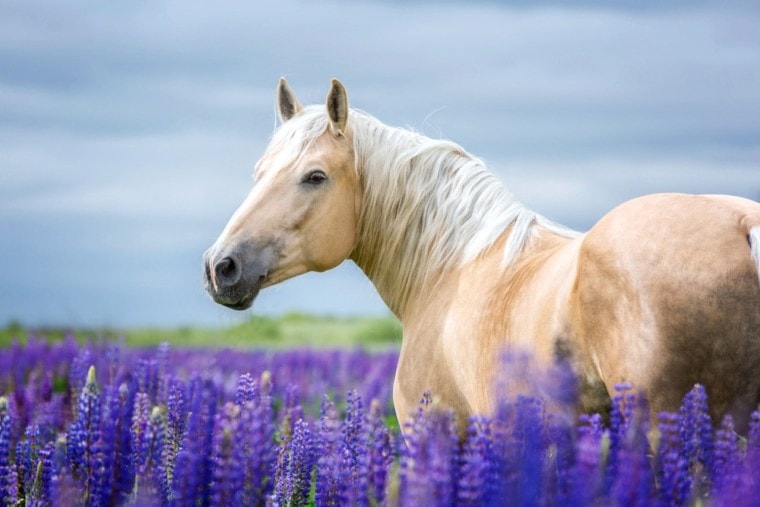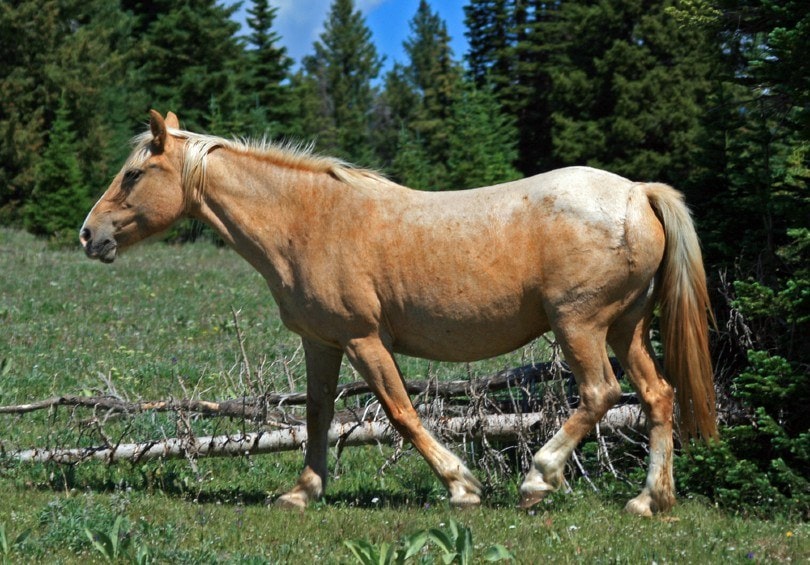
Click to Skip Ahead
Palomino horses are beautiful, but it should be noted that palomino is a color, not a breed. Many breeds of horses can be Palominos. That said, certain horse associations only allow certain breeds, such as Quarter Horses, to be included in their respective registries as Palominos. Read on to learn more about these exquisite equines, including their origin, varieties, and more.
Note: All of the Palomino characteristics used in this article are based on the Appaloosa Palomino.
Breed Overview
| Care Level: | High |
| Temperature: | Both cold and warm climates |
| Temperament: | Gentle, faithful, fierce, courageous |
| Colors: | Cream, yellow, gold |
| Lifespan: | 25–30 years |
| Weight: | 950–1,200 pounds |
| Height: | 14.2 hands (about 57 inches) to 16 hands (about 64 inches) |
The beautiful golden color of the Palomino results from a dilution gene that affects a horse with a base color of chestnut. Many Palominos are born with pinkish skin that darkens as they age.
Producing a Palomino is no small feat due to the unique factors needed to make one, including the “incomplete dominance” mutation. Due to this unique mutation, Palominos usually have characteristics that are far different from their parent horses. Even if you cross two Palominos, the chance that their foal will also be a Palomino is only about 50%.
Palomino Horse Breed Characteristics
What Are Palomino Horses Used For?
Although they’re typically used for shows, parades, and events, Palomino horses make excellent working horses and are found on farms and ranches worldwide, especially in the United States. Many owners keep Palomino horses as pets because they find the Palomino color so endearing, but you’ll also find these horses at rodeos and jumping competitions.
Since several breeds can have the Palomino coloring, stating what a particular horse would and could be used for is difficult unless the exact breed is specified. For example, when it comes to small-scale farming, some Palominos would be perfect for the job, while others wouldn’t be a good fit at all.

Where Did These Horses Originate From?
Unfortunately, the origins of the Palomino horse color are shrouded in mystery, especially since many species of horses can have the coveted coloring. One theory about the color is that it originated in an area of the world with an arid, desert climate.
That makes sense because the Palomino color is typically gold, yellow, or cream, and this would enable the horse to better blend in with their surroundings. The color can at least be traced back to The Crusades, possibly even further. In the United States, Palominos were introduced in the 1500s when Queen Isabella of Spain brought them to Texas.
Temperament & Intelligence of the Palomino Horse
The Palomino isn’t an actual breed but a color, which makes it impossible to say what any given Palomino’s temperament and intelligence would be, so let’s use an Appaloosa Palomino as an example.
The typical Appaloosa Palomino is known for being friendly, loyal, and gentle, so they’re often chosen as a horse for beginner riders and children. However, the Nez Perce Indians of the Columbia River Plateau relied heavily on Appaloosas because of their faithful nature, fierceness, and courage in battle.
Appearance & Varieties

Various breeds can have the Palomino color. The most commonly bred is the Quarter Horse, which makes up approximately 8% of the horses registered with the American Quarter Horse Association. Other breeds that are allowed to be registered as Palomino include the following:
Palomino horses are all similar, but the exact color has several variations. These include:
Things to Know When Owning a Palomino Horse
Habitat & Stable Requirements 🌾
Regardless of the breed, the Palimino requires plenty of room to exercise and adequate indoor and outdoor shelter. For example, when they’re outside in their paddock, a covered area where your horse can stand or lie down and stay warm and dry is essential.
When you stable your horse, you must ensure that their stable area is free of drafts, clean, and well-ventilated. Since your Palomino will be more exposed to germs and fumes when stabled, you must provide them with high-quality bedding that’s dust-free and changed regularly.
Depending on the breed of your Palomino, you should ensure that their stable is cool or warm enough for them to be comfortable. It should also be large enough for them to move around and lie down. Veterinarians recommend having a solid emergency plan in place should your Palomino’s stable catch fire or be flooded.
Food & Diet Requirements 🥕
All horses, including Palominos, are herbivores and need a well-balanced diet to stay healthy and live long lives. That includes an immense amount of fiber to keep their digestive tract working correctly. Since their G.I. tract is so long, horses must eat a small amount at a time all day.
Palomino horses should eat hay, haylage, and grass, but you can enhance their diet with fruits, vegetables, salt, and nutritional concentrates, depending on your veterinarian’s advice. Concentrates consist of corn, oats, or barley, which provide more energy for your horse. They are usually given to pregnant or nursing Palominos, younger horses that need more energy, and horses that compete.
Lastly, your Palomino must be given access to as much fresh, clean water as possible. If 24/7 access isn’t available, you must give your pet fresh water at least twice a day. However, don’t give them water right after eating, as it could cause a blockage in their GI tract. Water causes undigested food to move too rapidly through their intestines.
Exercise 🐎
Horses by their very nature are active animals, including Palominos. In the wild, for example, a feral horse usually travels between 20 and 30 miles daily. Your Palomino won’t need strenuous exercise, though. Aside from the occasional burst of speed, they need slow, steady walking, which they get when allowed to graze.
Veterinarians recommend providing a paddock that is 60 feet in diameter, which will give them plenty of room to walk, run, and otherwise stay active. Your Palomino should be allowed to stay in their paddock for several hours daily to get the exercise needed to be healthy.

Training 🐴
The training that your Palomino needs will vary greatly depending on the breed. For example, if your Palomino is used mainly for trail riding, it could take a few months to a year for the animal to be trained correctly.
Training a Palomino to compete in equestrian events could take upward of 3 years or longer and is a continuous process. In short, training your Palomino depends on what they will be used for and the difficulty of their job or sport.
Grooming 🧽
Veterinarians recommend grooming all horses daily, especially before a ride. This includes their hooves, which need to be kept as clean as possible to prevent health issues that could be damaging and painful.
Grooming your Palomino after a ride includes drying them off so they don’t get cold and stiff. This also helps reduce possible injuries and health issues that could negatively affect your pet. A typical grooming session takes 30 to 45 minutes and is a fantastic time to form a stronger bond with your Palomino.
If this is your first time owning a horse, you should seek horse grooming advice and tips from an expert. Someone you know who already owns a horse, your local veterinarian, or a horse training expert are all excellent choices for teaching you the basics of horse grooming.
Lifespan & Health Conditions (Based on the Appaloosa Palomino) 🏥
Although the Appaloosa Palomino is a relatively healthy and long-lived horse, they can suffer from several issues and disorders. One of the most common is congenital stationary night blindness (CSNB). With CSNB, Your Palomino’s retinas won’t work properly, and your pet will have problems seeing in low-light conditions.
Another possible health issue in Appaloosa Palominos is hyperkalemic periodic paralysis. It can cause muscle twitching, weakness, and difficulty breathing for your Palomino. It can even cause sudden death in severe cases, but it’s relatively rare.
Lastly, equine recurrent uveitis (ERU) is a problem that many Appaloosa Palominos share. ERU is unfortunately incurable and causes cataracts and glaucoma first, followed by blindness later in life.
Male vs. Female
Besides the general differences between male and female horses, the differences between a male and female Palomino are usually minimal. One issue with intact male Palominos is increased aggression. However, a Palomino raised in a caring and compassionate way will have fewer issues than one treated badly or abused.
3 Little-Known Facts About Palomino Horses
1. About 50% of All Registered Palominos Are Quarter Horses.
Quarter horses can reach high speeds over short distances and are famous for their speedy quarter-mile runs.
2. The Palomino Horse Association Allows Almost All Palominos to Be Registered, Regardless of Breed or Bloodline.
The only caveat is that the Palomino shouldn’t have any white markings.
3. Mr. Ed, the Famous “Talking” Horse From the Eponymous TV Show, Was a Palomino, as Was Roy Rodger’s Horse, Trigger.
“Hey Wilbur, look who’s famous!”

Final Thoughts
The one unique fact that sets Palomino horses apart from all others is their chestnut and golden color, which comes in different shades. Many horses can be Palominos, and their beautiful coloring is why they’ve been used in several TV shows and movies.
Due to their golden color, light mane, and poised elegant nature, Palominos have a unique place in the equine world. Also, since they’re a color and not a breed, the Palomino is an incredibly versatile horse.
Related Reads:
- 100+ Palomino Horse Names: Ideas for Golden & Royal Horses
- Grulla/Grullo Horse: Info, Pictures, Temperament & Traits
- How Much Does a Horse Cost?
Featured Image Credit: Osetrik, Shutterstock








